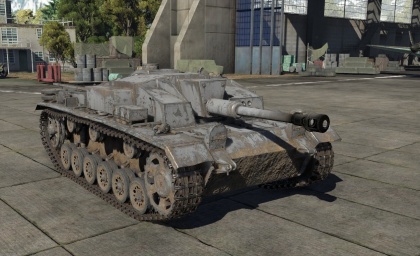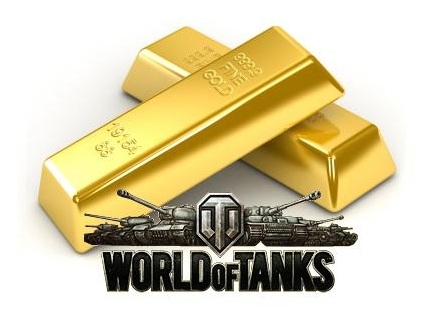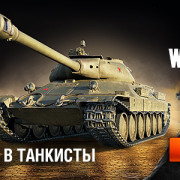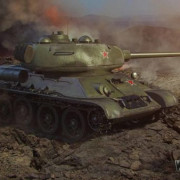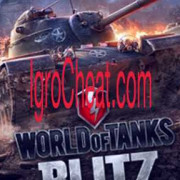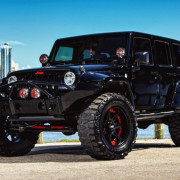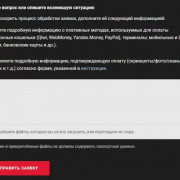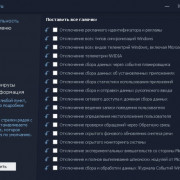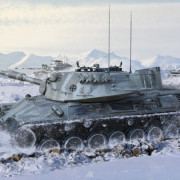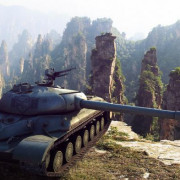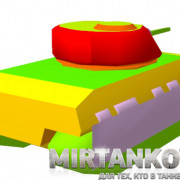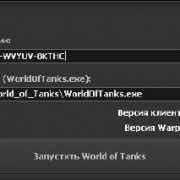Личный зачёт — stug iv
Содержание:
Боевое применение штурмового орудия StuG IV
Штурмовые орудия Sturmgeschuetz IV (StuG IV) применялись как в частях штурмовой артиллерии, так и в других танковых частях, в том числе в танковых, гренадерских и народно-гренадерских дивизиях.
Организация частей была той же, что и в частях StuG III/StuG 40.
Очень трудно установить границу, разделяющую машины StuG III и IV. В одних документах тип машин не указан, в других — все машины называются StuG III, хотя наверняка известно, что среди них были и StuG IV.
Много StuG IV попало в роты истребителей танков. Такие роты иногда входили в состав некоторых пехотных дивизий.
Различение типов штурмовых орудий можно найти лишь в списках пополнений рот истребителей танков и дивизионов штурмовой артиллерии. Если в феврале 1944 года в эти части попало 50 машин StuG IV, то в марте число достигло 60, в апреле 80, а в мае 90 штук. В марте и мае поставки новой техники шли исключительно за счет StuG IV.
Летом 1944 года на фронт ушло 214 штурмовых орудий StuG IV: в июне 70 штук, в июле 94 штуки, в августе 50 штук. До конца года поступило ещё 220 машин; 70 в сентябре, 80 в октябре, 30 в ноябре и 40 в декабре. Всего 744 машин. Так как всего было выпущено 1138 штурмовых орудий этого типа, можно предположить, что остальные машины попали в отдельные части штурмовой артиллерии и танковые части. В 1944/45 годах во многих танковых ротах и батальонах вместо отсутствующих танков использовались штурмовые орудия. Например, с ноября 1944 года целиком штурмовыми орудиями была оснащена 5-я рота 3-го танкового полка 2-й танковой дивизии. Летом 1944 года около 70 штурмовых орудий StuG IV поступило в части SS, в том числе в 17-ю гренадёрскую дивизию SS «Goetz von Berlichingen».

Самоходное штурмовое орудие StuG IV, вид спереди
В 1944 году на Западном фронте действовала 394-я бригада штурмовой артиллерии. Две батареи этой бригады были оснащены StuG IV. 6 августа бригада сожгла 26 американских танков, в том числе 6 записал на свой счёт командир 3-й батареи, капитан фон Йена. За это капитан был представлен к Рыцарскому кресту. Вскоре бригада потеряла все свои машины в котле под Фалезом.
Весной 1944 года первые StuG IV получила 311-я бригада. Часть действовала в районе Тернополя, взаимодействуя с II танковым корпусом SS. Конец войны бригада встретила в окруженном Бреслау. К моменту капитуляции в бригаде оставалось одно штурмовое орудие StuG IV.
Есть подтвержденные данные о том, что машины StuG IV входили в состав 226-й бригады. В марте 1945 года бригада сражалась в районе Сопота, 30 марта удерживала позиции в районе Гранд-Отеля. 236-я бригада штурмовой артиллерии действовала на участке фронта II армии Войска Польского в апреле 1945 года. В боях на Балатоне и под Комарно участвовала 3-я батарея 239-й бригады, также оснащенная StuG IV.
12 машин этого типа входило в состав 1269-й роты истребителей танков лейтенанта Гудера. В феврале 1945 года рота действовала на Западном Поморье, в районе Штаргарда и Бялогарда. В апреле 1945 года рота оборонялась в Щецине. В боях под Пилой и Познанью участвовали машины II образцовой бригады штурмовой артиллерии.
В Курляндии действовали StuG IV из 912-й бригады. В 1-й батарее капитана Шуберта и во 2-й батарее капитана Эггхардта было в общей сложности около 30 штурмовых орудий StuG IV, многие из которых в мае 1945 года попали в руки советских войск.
В Италии действовали штурмовые орудия 914-й бригаде. Они участвовали в боях на линии Готов и в Анконе.
1253-я рота легких истребителей танков использовала машины StuG IV в качестве буксиров пушек и грузовиков. Кроме того, личный состав роты не был достаточно подготовлен, а в полевых условиях уже не было времени наверстывать упущенное. Наладить взаимодействие с пехотой не удалось. Командир 1253-й роты отрицательно отзывался о машинах StuG IV, поскольку они не имели пулеметов.
Development
The Sturmgeschütz III originated from German experiences in World War I, when it was discovered that during the offensives on the western front, the infantry lacked the means to effectively engage fortifications. The artillery of the time was heavy and not mobile enough to keep up with the advancing infantry to destroy bunkers, pillboxes, and other minor obstacles with direct-fire. Although the problem was well-known in the German army, it was General Erich von Manstein, who is considered the father of the Sturmartillerie, that saw the solution. The initial proposal was from (then) Colonel Erich von Manstein, and submitted to General Ludwig Beck in 1935, suggesting that Sturmartillerie («assault artillery») units should be used in a direct-fire support role for infantry divisions. On June 15, 1936, Daimler-Benz AG received an order to develop an armored infantry-support vehicle capable of mounting a 75 mm (2.95 in) artillery piece. The gun mount’s fixed, fully-integrated casemate superstructure was to allow a limited traverse of a minimum of 25° and provided overhead protection for the crew. The height of the vehicle was not to exceed that of the average man.
Daimler-Benz AG used the chassis and running gear of its recently designed Pz.Kpfw. III medium tank as a basis for the new vehicle. Prototype manufacture was passed over to Alkett, which produced five examples in 1937 of the experimental 0-series StuG based upon the Pz.Kpfw. III Ausf. B. These prototypes featured a mild-steel superstructure and Krupp’s short-barreled 75 mm StuK 37 L/24 cannon. This model was known as the Sturmgeschütz Ausführung A.
Side drawing of a Assault Gun III, Variant A
Side drawing of a Assault Gun III, Variant G (December 1942)
While the StuG III was considered self-propelled artillery, it was not initially clear which arm of the Wehrmacht would handle the new weapon. The Panzer arm, who was the natural user of tracked fighting vehicles, had no resources to spare for the formation of StuG units, and neither did the infantry branch. It was agreed, after a discussion, it would best be employed as part of the artillery arm.
The StuGs were organized into battalions (later renamed «brigades» for disinformation purposes) and followed their own specific doctrine. Infantry support using direct-fire was its intended role. Later, there was also a strong emphasis on destroying enemy armor whenever encountered.
As the StuG III was designed to fill an infantry close support combat role, early models were fitted with a low-velocity 75 mm StuK 37 L/24 gun to destroy soft-skin targets and fortifications. After the Germans encountered the Soviet KV-1 and T-34 tanks, the StuG III was equipped with a high-velocity 75 mm StuK 40 L/43 main gun (Spring 1942) and later, the 75 mm StuK 40 L/48 (Autumn 1942) anti-tank gun. These versions were known as the Sturmgeschütz 40 Ausführung F, Ausf. F/8, and Ausf. G.
When the StuG IV entered production in late 1943 and early 1944, the «III» was added to the name to separate it from the Panzer IV-based assault guns. All previous and following models were thereafter known as Sturmgeschütz III.
Beginning with the StuG III Ausf. G, a 7.92 mm MG34 could be mounted on a shield on top of the superstructure for added anti-infantry protection from December 1942. Some of the F/8 models were retrofitted with a shield as well. Many of the later StuG III Ausf. G models were equipped with an additional coaxial 7.92 mm MG34.
The vehicles of the Sturmgeschütz series were cheaper and faster to build than contemporary German tanks; at 82,500 RM, a StuG III Ausf G was cheaper than a Panzer III Ausf. M, which cost 103,163 RM. This was due to the omission of the turret, which greatly simplified manufacture and allowed the chassis to carry a larger gun than it could otherwise. By the end of the war, 10,619 StuG IIIs and StuH 42s had been built.
Modules
Guns
| Gun | Penetration(mm) | Damage(HP) | Rate of fire(rounds/minute) | Dispersion(m/100m) | Aiming time(s) | Weight(kg) |
Price( ) |
||
|---|---|---|---|---|---|---|---|---|---|
| IV | 7,5 cm Kanone L/24 | 43/87/38 | 110/110/175 | 15.38 | 0.55 | 1.7 | 780 | 10450 | |
| IV | 7,5 cm Stu.K. 40 L/43 | 103/139/38 | 110/110/175 | 15.38 | 0.39 | 1.8 | 1437 | 25000 | |
| V | 7,5 cm Pak 39 L/48 | 110/158/38 | 110/110/175 | 15.38 | 0.36 | 1.7 | 1520 | 27380 | |
| V | 10,5 cm Stu.H. 42 L/28 | 64/104/53 | 350/350/410 | 6.67 | 0.55 | 2 | 2100 | 28000 |
Engines
| Engine | Engine Power(hp) | Chance of Fire on Impact(%) | Weight(kg) |
Price( ) |
||
|---|---|---|---|---|---|---|
| IV | Maybach HL 108 TR | 320 | 20 | 450 | 9460 | |
| IV | Maybach HL 120 TR | 350 | 20 | 510 | 10430 | |
| IV | Maybach HL 120 TRM | 440 | 20 | 510 | 19900 |
Suspensions
| Suspension | Load Limit(т) | Traverse Speed(gr/sec) | min | Weight(kg) |
Price( ) |
||
|---|---|---|---|---|---|---|---|
| III | StuG III Ausf. B | 24 | 32 | 5350 | 1800 | ||
| IV | StuG III Ausf. E | 26.5 | 40 | 5350 | 4740 |
Operational history
A StuG III destroyed in Normandy, 1944. This vehicle likely suffered a catastrophic internal explosion.
Overall, Sturmgeschütz-series assault guns proved very successful and served on all fronts as assault guns and tank-destroyers. Although Tigers and Panthers have earned a greater notoriety, assault guns collectively destroyed more tanks. Because of their low silhouette, StuG IIIs were easy to camouflage and a difficult target. Sturmgeschütz crews were considered to be the elite of the artillery units. Sturmgeschütz units held a very impressive record of tank kills: some 20,000 enemy tanks by the spring of 1944. As of April 10, 1945, there were 1,053 StuG IIIs and 277 StuH 42s in service. Approximately 9,500 StuG IIIs of various types were produced until March 1945 by Alkett and a small number by MIAG.
In terms of the resources expended in their construction, the StuG assault guns were extremely cost-effective compared to the heavier German tanks, though in the anti-tank role, it was best used defensively, as the lack of a traversable turret would be a severe disadvantage in the assault role. As the German military situation deteriorated later in the war, more and more StuG guns were constructed in comparison to tanks: an effort to replace losses and bolster defences against the encroaching Allied forces.
In 1944, the Finnish Army received 59 StuG III Ausf. Gs from Germany (30 Stu 40 Ausf.G and 29 StuG III Ausf. G) and used them against the Soviet Union. These destroyed at least 87 enemy tanks for a loss of only 8 StuGs (some of these were destroyed by their crews to avoid capture). After the war, they were the main combat vehicles of the Finnish Army until the early 1960s. These StuGs gained the nickname «Sturmi» which can be found in some plastic kit models.
Sturmgeschütz III Ausf G, captured from the Syrian Army, in Yad la-Shiryon Museum, Israel.
100 StuG III Ausf. G were delivered to Romania in the autumn of 1943. They were officially known as TAs (or TAs T3 to avoid confusion with TAs T4) in the army inventory. By February 1945, 13 units were still in use with the 2nd Armored Regiment. None of this initial batch survived the end of the war. 31 TAs were on the army inventory in November 1947. Most of them were probably StuG III Ausf. Gs and a small number of Panzer IV/70 (V)s, known as TAs T4s. These TAs were supplied by the Red Army or were damaged units repaired by the Romanian Army. All German equipment was scrapped in 1954 due to the Army’s decision to use Soviet armor.
StuG IIIs were also exported to other nations such as Bulgaria, Hungary, Italy, and Spain.
Many German Sturmgeschütz IIIs were captured by Yugoslav Partisans. After the war, they were used by the Yugoslav Peoples Army until the 1950s.
Development
The Sturmgeschütz III originated from German experiences in World War I, when it was discovered that during the offensives on the western front, the infantry lacked the means to effectively engage fortifications. The artillery of the time was heavy and not mobile enough to keep up with the advancing infantry to destroy bunkers, pillboxes, and other minor obstacles with direct-fire. Although the problem was well-known in the German army, it was General Erich von Manstein, who is considered the father of the Sturmartillerie, that saw the solution. The initial proposal was from (then) Colonel Erich von Manstein, and submitted to General Ludwig Beck in 1935, suggesting that Sturmartillerie («assault artillery») units should be used in a direct-fire support role for infantry divisions. On June 15, 1936, Daimler-Benz AG received an order to develop an armored infantry-support vehicle capable of mounting a 75 mm (2.95 in) artillery piece. The gun mount’s fixed, fully-integrated casemate superstructure was to allow a limited traverse of a minimum of 25° and provided overhead protection for the crew. The height of the vehicle was not to exceed that of the average man.
Daimler-Benz AG used the chassis and running gear of its recently designed Pz.Kpfw. III medium tank as a basis for the new vehicle. Prototype manufacture was passed over to Alkett, which produced five examples in 1937 of the experimental 0-series StuG based upon the Pz.Kpfw. III Ausf. B. These prototypes featured a mild-steel superstructure and Krupp’s short-barreled 75 mm StuK 37 L/24 cannon. This model was known as the Sturmgeschütz Ausführung A.
Side drawing of a Assault Gun III, Variant A
Side drawing of a Assault Gun III, Variant G (December 1942)
While the StuG III was considered self-propelled artillery, it was not initially clear which arm of the Wehrmacht would handle the new weapon. The Panzer arm, who was the natural user of tracked fighting vehicles, had no resources to spare for the formation of StuG units, and neither did the infantry branch. It was agreed, after a discussion, it would best be employed as part of the artillery arm.
The StuGs were organized into battalions (later renamed «brigades» for disinformation purposes) and followed their own specific doctrine. Infantry support using direct-fire was its intended role. Later, there was also a strong emphasis on destroying enemy armor whenever encountered.
As the StuG III was designed to fill an infantry close support combat role, early models were fitted with a low-velocity 75 mm StuK 37 L/24 gun to destroy soft-skin targets and fortifications. After the Germans encountered the Soviet KV-1 and T-34 tanks, the StuG III was equipped with a high-velocity 75 mm StuK 40 L/43 main gun (Spring 1942) and later, the 75 mm StuK 40 L/48 (Autumn 1942) anti-tank gun. These versions were known as the Sturmgeschütz 40 Ausführung F, Ausf. F/8, and Ausf. G.
When the StuG IV entered production in late 1943 and early 1944, the «III» was added to the name to separate it from the Panzer IV-based assault guns. All previous and following models were thereafter known as Sturmgeschütz III.
Beginning with the StuG III Ausf. G, a 7.92 mm MG34 could be mounted on a shield on top of the superstructure for added anti-infantry protection from December 1942. Some of the F/8 models were retrofitted with a shield as well. Many of the later StuG III Ausf. G models were equipped with an additional coaxial 7.92 mm MG34.
The vehicles of the Sturmgeschütz series were cheaper and faster to build than contemporary German tanks; at 82,500 RM, a StuG III Ausf G was cheaper than a Panzer III Ausf. M, which cost 103,163 RM. This was due to the omission of the turret, which greatly simplified manufacture and allowed the chassis to carry a larger gun than it could otherwise. By the end of the war, 10,619 StuG IIIs and StuH 42s had been built.
Modules
Guns
| Gun | Penetration(mm) | Damage(HP) | Rate of fire(rounds/minute) | Dispersion(m/100m) | Aiming time(s) | Weight(kg) |
Price( ) |
||
|---|---|---|---|---|---|---|---|---|---|
| IV | 7,5 cm Stu.K. 40 L/43 | 103/139/38 | 110/110/175 | 15.38 | 0.39 | 1.7 | 1437 | 25000 | |
| V | 7,5 cm Pak 39 L/48 | 110/158/38 | 110/110/175 | 15.38 | 0.37 | 1.7 | 1520 | 27380 | |
| VI | 7,5 cm Pak 42 L/70 | 150/194/38 | 135/135/175 | 13.33 | 0.33 | 1.7 | 1740 | 53000 | |
| V | 10,5 cm Stu.H. 42 L/28 | 64/104/53 | 350/350/410 | 8.33 | 0.53 | 1.7 | 2100 | 28000 |
Engines
| Engine | Engine Power(hp) | Chance of Fire on Impact(%) | Weight(kg) |
Price( ) |
||
|---|---|---|---|---|---|---|
| IV | Maybach HL 108 TR | 320 | 20 | 450 | 9460 | |
| IV | Maybach HL 120 TR | 350 | 20 | 510 | 10430 | |
| IV | Maybach HL 120 TRM | 440 | 20 | 510 | 19900 |
Suspensions
| Suspension | Load Limit(т) | Traverse Speed(gr/sec) | min | Weight(kg) |
Price( ) |
||
|---|---|---|---|---|---|---|---|
| III | StuG III Ausf. F | 22.94 | 39 | 5350 | 1660 | ||
| IV | StuG III Ausf. G | 25.69 | 47 | 5850 | 4740 |
Историческая справка
-
Основная статья: История StuG III Ausf. G
Sturmgeschütz III (StuG III; Штурмгешютц III, Штуг III) — средняя по массе немецкая самоходно-артиллерийская установка класса штурмовых орудий времён Второй мировой войны на базе танка Pz.Kpfw. III. Серийно выпускалась в различных модификациях с 1940 по 1945 год и стала самым массовым по численности представителем бронетехники вермахта (выпущено 8636 самоходок с 75-мм орудиями).
StuG III — компоновка боевого отделения и размещение в нём экипажа
Полное официальное название машины — Gepanzerte Selbstfahrlafette für Sturmgeschütz 7,5 cm Kanone. По ведомственному рубрикатору министерства вооружений нацистской Германии самоходка обозначалась как Sd.Kfz.142. StuG III также обозначается как StuG 40, в советской литературе эту машину именовали как «Артштурм». StuG III активно использовались на всех фронтах Второй мировой войны и в целом получили хорошие отзывы немецкого командования: к началу 1944 на счету StuG III было около 20 000 танков противника. Захваченные Красной армией StuG III переделывались в самоходки СУ-76и.
Источники информации
- Wolfgang Fleischer: Die deutschen Sturmgeschütze 1935–1945, Podzun-Pallas Verlag, ISBN 3-7909-0588-7
- J. Rickard. Sturmgeschütz. 6 August 2008
Ссылки
- Ресурсы World of Tanks
- Танковедение
- Тема на официальном форуме
- Материал на Warspot
- Записи боев на StuG III Ausf. B
- В сети Интернет
StuG III // Википедия
Техника Германии
| Лёгкие танки | I Leichttraktor • II Pz.Kpfw. II Ausf. D • II MKA • II Pz.Kpfw. 38H 735 (f) • II Pz.Kpfw. 35 (t) • II Pz.Kpfw. I • II Pz.Kpfw. II • III 43 M. Toldi III • III Pz.Kpfw. 38 (t) • III Pz.Kpfw. III Ausf. E • III Pz.Kpfw. II Ausf. J • III Pz.Kpfw. I Ausf. C • III Pz.Kpfw. II Ausf. G • III Pz.Kpfw. T 15 • IV Pz.Kpfw. 38 (t) n.A. • IV Pz.Kpfw. II Luchs • V VK 16.02 Leopard • VI VK 28.01 • VII Aufklärungspanzer Panther • VII Spähpanzer SP I C • VIII leKpz M 41 90 mm • VIII leKpz M 41 90 mm GF • VIII HWK 12 • VIII HWK 30 • IX Spähpanzer Ru 251 • X Rheinmetall Panzerwagen |
| Средние танки | III Großtraktor — Krupp • III Pz.Kpfw. IV Ausf. A • III Pz.Kpfw. S35 739 (f) • IV Pz.Kpfw. III Ausf. J • IV Pz.Kpfw. IV Ausf. D • IV VK 20.01 (D) • V Pz.Kpfw. III Ausf. K • V Turán III prototípus • V Pz.Kpfw. III/IV • V Pz.Kpfw. IV hydrostat. • V Pz.Kpfw. V/IV • V Pz.Kpfw. V/IV Alpha • V Pz.Kpfw. IV Ausf. H • V Pz.Kpfw. T 25 • V VK 30.01 (H) • VI Pz.Kpfw. IV Schmalturm • VI VK 30.01 (D) • VI VK 30.02 (M) • VII Panther/M10 • VII Panther • VII VK 30.02 (D) • VIII Panther mit 8,8 cm L/71 • VIII Panzer 58 • VIII Schwarzpanzer 58 • VIII Panzer 58 Mutz • VIII M48A2 Räumpanzer • VIII Indien-Panzer • VIII Panther II • IX E 50 • IX T 55A • IX Kampfpanzer 50 t • IX Leopard Prototyp A • X E 50 Ausf. M • X Leopard 1 |
| Тяжёлые танки | IV Pz.Kpfw. B2 740 (f) • IV Durchbruchswagen 2 • VI Tiger 131 • VI VK 30.01 (P) • VI VK 36.01 (H) • VII VK 45.03 • VII Tiger I • VII Tiger (P) • VIII VK 100.01 (P) • VIII VK 168.01 (P) • VIII VK 168.01 Mauerbrecher • VIII VK 75.01 (K) • VIII E 75 TS • VIII Löwe • VIII Tiger II • VIII VK 45.02 (P) Ausf. A • IX E 75 • IX Mäuschen • IX VK 45.02 (P) Ausf. B • X E 100 • X Pz.Kpfw. VII • X Maus • X VK 72.01 (K) |
| ПТ-САУ | II Panzerjäger I • III Marder II • IV StuG III Ausf. B • IV Jagdpanzer 38(t) Hetzer • IV Marder 38T • V StuG IV • V Pz.Sfl. IVc • V StuG III Ausf. G • VI Dicker Max • VI Jagdpanzer IV • VI Nashorn • VII E 25 • VII Krupp-Steyr Waffenträger • VII Jagdpanther • VII Sturer Emil • VIII Ferdinand • VIII Kanonenjagdpanzer 105 • VIII Rheinmetall Skorpion G • VIII Rheinmetall Skorpion • VIII Jagdpanther II • VIII 8,8 cm Pak 43 Jagdtiger • VIII Rhm.-Borsig Waffenträger • IX Jagdtiger • IX Waffenträger auf Pz. IV • X Grille 15 • X Jagdpanzer E 100 • X Waffenträger auf E 100 |
| САУ | II G.Pz. Mk. VI (e) • III Sturmpanzer I Bison • III Wespe • IV Pz.Sfl. IVb • IV Sturmpanzer II • V Grille • VI Hummel • VII G.W. Panther • VIII G.W. Tiger (P) • IX G.W. Tiger • X G.W. E 100 |
Противотанковые САУ
| Техника СССР | II АТ-1 • III СУ-76И • IV СУ-85А • IV СУ-76М • V СУ-85 • V СУ-85И • VI СУ-100 • VI СУ-100Y • VII ИСУ-122С • VII СУ-152 • VII СУ-100М1 • VII СУ-122-44 • VIII ИСУ-152 • VIII ИСУ-130 • VIII Т-103 • VIII СУ-130ПМ • VIII СУ-101 • IX Объект 704 • IX Объект 263 • X Объект 268 • X Объект 268 Вариант 4 |
| Техника Германии | II Panzerjäger I • III Marder II • IV StuG III Ausf. B • IV Jagdpanzer 38(t) Hetzer • IV Marder 38T • V StuG IV • V Pz.Sfl. IVc • V StuG III Ausf. G • VI Dicker Max • VI Jagdpanzer IV • VI Nashorn • VII E 25 • VII Krupp-Steyr Waffenträger • VII Jagdpanther • VII Sturer Emil • VIII Ferdinand • VIII Kanonenjagdpanzer 105 • VIII Rheinmetall Skorpion G • VIII Rheinmetall Skorpion • VIII Jagdpanther II • VIII 8,8 cm Pak 43 Jagdtiger • VIII Rhm.-Borsig Waffenträger • IX Jagdtiger • IX Waffenträger auf Pz. IV • X Grille 15 • X Jagdpanzer E 100 • X Waffenträger auf E 100 |
| Техника США | II T3 HMC • III T56 GMC • IV M8A1 • IV T40 • V M10 Wolverine • V T67 • VI T78 • VI M18 Hellcat • VI M36 Jackson • VII M56 Scorpion • VII T28 Concept • VII Super Hellcat • VII T25/2 • VII T25 AT • VIII TS-5 • VIII T28 • VIII T28 Prototype • IX T30 • IX T95 • X T110E3 • X T110E4 |
| Техника Франции | II Renault FT AC • III FCM 36 Pak 40 • III Renault UE 57 • IV Somua SAu 40 • V M10 RBFM • V S35 CA • VI ARL V39 • VII AMX AC mle. 46 • VIII AMX AC mle. 48 • VIII AMX Canon d’assaut 105 • IX AMX 50 Foch • X AMX 50 Foch (155) • X AMX 50 Foch B |
| Техника Великобритании | II Universal Carrier 2-pdr • IV Valentine AT • IV Alecto • V Archer • V AT 2 • VI Churchill Gun Carrier • VI Achilles • VI AT 8 • VI Excalibur • VII Challenger • VII AT 15A • VII AT 7 • VIII AT 15 • VIII Charioteer • VIII Turtle Mk. I • IX Tortoise • IX FV4004 Conway • X FV215b (183) • X FV4005 Stage II • X FV217 Badger |
| Техника Китая | II T-26G FT • III M3G FT • IV SU-76G FT • V 60G FT • VI WZ-131G FT • VII T-34-2G FT • VIII WZ-111-1G FT • VIII WZ-120-1G FT • IX WZ-111G FT • X WZ-113G FT |
| Техника Швеции | II Pvlvv fm/42 • III Ikv 72 • IV Sav m/43 • V Ikv 103 • VI Ikv 65 Alt II • VII Ikv 90 Typ B • VIII UDES 03 • VIII Strv S1 • IX Strv 103-0 • X Strv 103B |
Конструкция штурмового орудия StuG IV
В качестве шасси для штурмового орудия StuG IV использовался корпус танка PzKpfw IV Ausf. H (позднее PzKpfw IV Ausf. J) сваренный из гетерогенных бронеплит.
Вместо танковой башни Sturmgeschuetz IV оснащался рубкой, сваренной из бронеплит толщиной 11–80 мм. Крыша рубки крепилась с помощью болтов и была съёмной, что облегчало капитальный ремонт или замену пушки. Рубка соединялась с корпусом с помощью болтов и уголков.
В крыше рубки имелась командирская башенка. Толщина брони башенки 30–50 мм. Рядом с люком заряжающего на крыше стоял пулемет MG 42 калибра 7,92 мм.
Ходовая часть StuG IV состояла из восьми обрезиненных опорных катков малого диаметра размером 470×75×660, собранных в четыре тележки. Верхний участок гусеницы поддерживали четыре (Ausf. Н и ранние Ausf. J) или три (Ausf. J) поддерживающих катка. Поддерживающие катки обычно были цельнометаллические, лишь у немногих ранних машин они имели резиновый бандаж. Каждый поддерживающий каток подвешивался на подшипнике к оси, которая, в свою очередь, крепилась к борту с помощью четырёх болтов М20. В конце войны появились цельнометаллические опорные катки.
Направляющее колесо с механизмом натяжения располагалось на корме, а ведущее колесо с 20 зубьями находилось спереди.
Гусеницы одношкворневые, одногребневые Kgs 61/400/120. Опорная длина гусеницы 3720 мм. Гусеницы из марганцевой стали. В зимних условиях на гусеницы можно было надевать антипробуксовочные зубья и специальные накладки, увеличивающие ширину гусеницы. Каждая гусеница состояла из 99 траков.
Двигатель Maybach HL 120 TRN, карбюраторный, четырехтактный, 12-цилиндровый, рядный, V-образный (развал блоков 60°), верхнеклапанный, жидкостного охлаждения. Радиаторы располагались слева и справа от двигателя. Имелась система вентилей, позволявшая заливать двигатель теплой или горячей водой. Циркуляцию воздуха в двигательном отделении обеспечивали два вентилятора, расположенных в правой части корпуса. На надмоторной плите имелись два прямоугольных отверстия. Воздухозаборники также располагались по бортам.
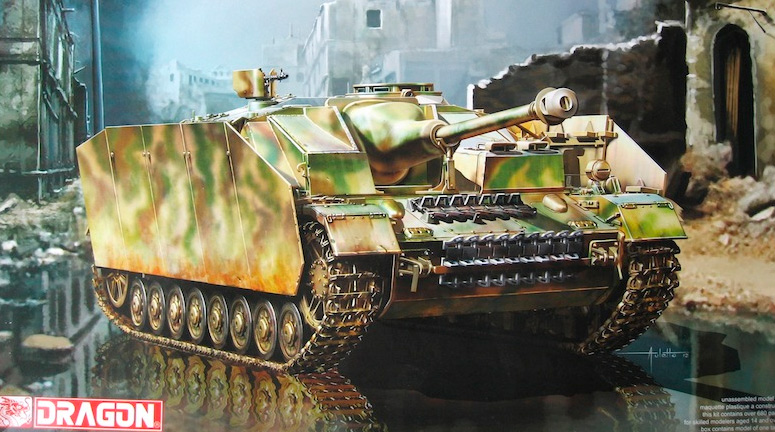
StuG IV с дополнительной защитой бортов
Топливо — этилированный бензин OZ 74. Бензин был разлит по трём бакам общей ёмкостью 430 л. В первом баке вмещалось 140 литров, во втором 120, а в третьем 170. Обычно в баки заливали 413 л топлива. Для залива топлива использовались два отверстия, расположенные в районе поддерживающего катка. Расход топлива 195 л на 100 км, запас хода по шоссе 210 км, 130 км по пересеченной местности. Два карбюратора типа Solex.
Передачи переключались с помощью рычага, расположенного справа от места механика-водителя. Управление осуществлялось с помощью рулевой системы, состоявшей из планетарных механизмов поворота, бортовых передач и ведущих колёс. Тормоза механические, типа Krupp.
Основным вооружением машины была 75-мм пушка 7.5 cm StuK 40 L/48. Пушка могла вести огонь бронебойными снарядами PzGr 39 массой 6,8 кг и начальной скоростью 740-790 м/с, подкалиберными снарядами PzGr 40 массой 4,1 кг и начальной скоростью 920–1060 м/с, кумулятивными Gr 38HL/B массой 4,4 кг и начальной скоростью 870 м/с, фугасными SpGr 34 массой 5,72 кг и начальной скоростью 590 м/с, а также дымовыми NbGr массой 6,21 кг и начальной скоростью 580 м/с. Боекомплект 63 выстрела.
Ствол нарезной с 32 нарезами глубиной 7,8 мм. Спуск электрический.
Дополнительное вооружение состояло из пулемета MG 34 (MG 42) калибра 7,92 мм (500 патронов), установленного на крыше рубки на так называемом лафете Rundumfeuer MG, позволяющим вести огонь из боевого отделения.
Радиооборудование состояло из радиостанции FuG 15 и FuG 16. Приемник УКВ FuG 15 тип «h» работал в диапазоне 23000–24950 кГц. Радиус действия 4 км ключ, 2 км телефон. Приемопередатчик FuG 16 состоял из 10-ваттного передатчика тип «h» и приемника тип «h» и работал в диапазоне 23000–24950 кГц. Обе радиостанции имели штыревые антенны длиной 2 метра. Антенны крепились к задней стенке рубки. Машина также была оборудована системой внутренней связи.
Командир машины располагал артиллерийской стереотрубой SF 14z (Schrenfernrohr 14z). В башенке было установлено семь перископов. Место механика водителя оборудовалось двумя перископами.
Дополнительное оборудование состояло из сапёрных инструментов (топор, молот, лом, лопата и ножницы для резки колючей проволоки). Их перевозили на крыльях машины. На правом крыле также имелась рукоятка стартёра, а на левом — орудийный банник. На левом борту рубки хранили два запасных опорных катка.
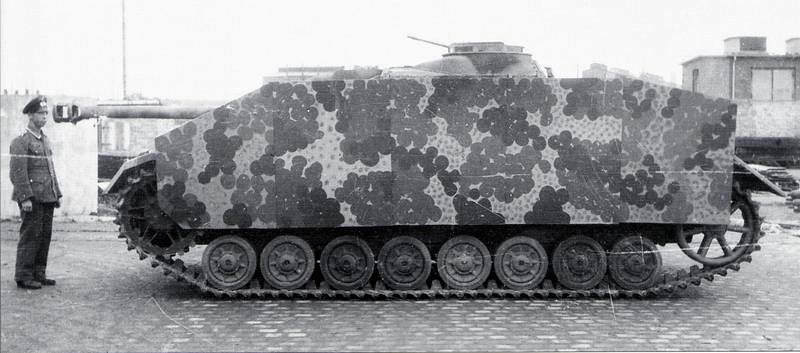
Дополнительная защита борта StuG IV навесными стальными листами
